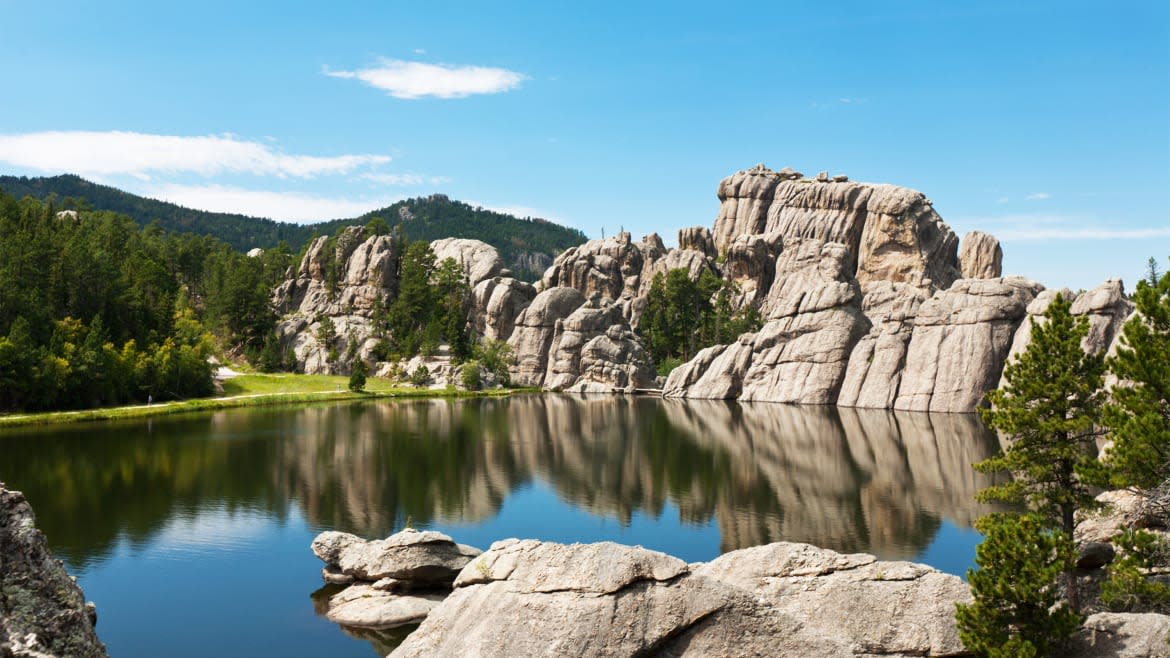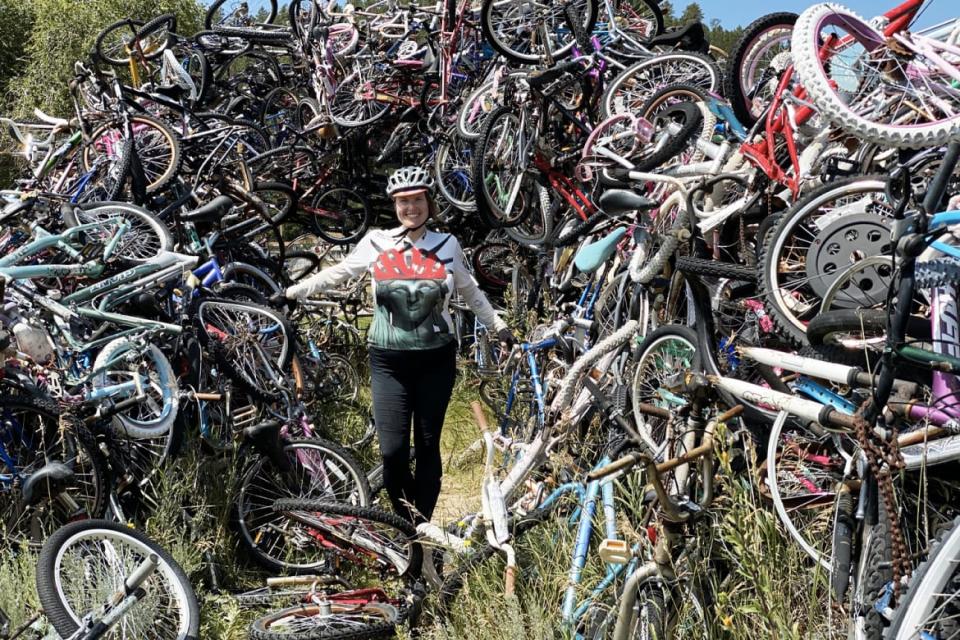The Best Way to See South Dakota? This Former Railroad Trail

Last month, I joined an estimated 365,000 leather-clad bikers in South Dakota to hit the open roads on two wheels. Beards were thick; tattoos were plentiful; Trump flags were everywhere. August 2020 marked the 80th anniversary of the Sturgis Motorcycle Rally in Sturgis, South Dakota, but that’s not what took me to this sparsely populated Plains state. Sure, my ride had two wheels but my “bike” was pedal powered; my destination, the George S. Mickelson Trail, a 109-mile car-free rail trail through the Black Hills region of South Dakota.
I’m originally from Milwaukee, the birthplace of Harley Davidson Motorcycles. My uncle worked as a machinist at Harley Davidson for 18 years and I sold T-shirts at Harley’s 100th Anniversary when I was in college. The motorcycle scene isn’t new to me. For the past 15 years, however, I’ve lived in New York City, where you can often catch me sipping home-brewed kombucha in a Bernie Sanders T-shirt. I don’t exactly fit in at motorcycle rallies. To avoid the crowds and accompanying COVID-19 cases, I headed to Sturgis on a drizzly, overcast afternoon when the half dollar-size hail forecast kept most riders away. I spent about an hour there, which was long enough to take a few pictures, buy one of the few women’s T-shirts that didn’t have an Elvira-plunge neckline, and get kicked off the main drag—“Sorry, motorcycles only.” The highlight of my visit to Sturgis? The food worker who yelled out “Bicycle Lives Matter!” You can be sure there were no “Black Lives Matter” T-shirts in this crowd.
South Dakota is well known for its spectacular parks and historic monuments: Badlands National Park’s canyons, buttes, and fossil beds; Wind Cave National Park’s underground cave network—one of the largest and most complex in the world; Custer State Park’s herd of 1,300 buffalo; Mount Rushmore, Crazy Horse Memorial, and countless other historic sites. Fourteen million travelers visit these sites in South Dakota each year but only a tiny fraction of them make it to the Mickelson Trail.

Named after a former South Dakota Governor who helped spearhead the project, the George S. Mickelson Trail stretches from the wild west town of Deadwood to the sleepy, semi-ghost town of Edgemont. Though no campsites exist right along the trail, primitive camping is available and plenty of hotels are located along the route. The trail is well organized and its clearly marked trailheads have maps, informative historical plaques, bathrooms, and clean drinking water. Several trailheads even have bike repair stations where you can borrow tools or pump up tires. Why aren’t more people riding this trail? One local rider I met (who admitted to originally being from Washington State), heard me mention that I live in New York City and told me not to tell anyone about the trail. I couldn’t tell if he was joking. Oops.
As the author of a cycling guidebook to Cuba, I should be physically prepared to ride 109 miles in two days. I pride myself on once having ridden 107 miles in a single day on a single speed (gearless) bicycle—shout out to the New York City Century ride!—but that was a couple years ago. These are pandemic days, days that I usually spend baking cookies and doing puzzles at my kitchen table. Sure, I’ve been hiking and biking here and there and have even done a few 60-mile rides, but I was nervous to attempt the Mickelson Trail in two days—the only time left after I’d spent the entire week visiting National and State Parks (how typical). Though the trail is well maintained and does not require a mountain bike, it consists of crushed limestone and gravel, which require a bit more effort than pavement, so I decided to rent an e-bike.
Aside from accidentally grabbing an electric CitiBike, the bike share program in New York City (then subsequently being charged extra for doing so), I have zero experience with e-bikes. They’re growing in popularity across the country and they’re massively popular with food delivery workers in New York City who are quick to pass you going uphill while smoking a cigarette and talking on their phone.
Finding a rental bike—electric or otherwise—near the trail is much more difficult than you’d expect. Like the rest of the country, the pandemic has contributed to a bicycle shortage in the state and bike shops just can’t keep bikes on the shelves. ACME Bicycles in Rapid City, South Dakota normally rents out high-quality bikes (and is a wealth of knowledge for anyone planning to bike in the state), but they temporarily eliminated their bike rental program due to COVID-19. Demand for bike purchases was so high that they sold their fleet of rental bikes but plan to purchase a new fleet in 2021. They’re also looking into opening a second shop in Hill City, approximately the midway point along the Mickelson Trail, to support trail riders.
Most of ACME’s customers ship their bikes to the shop in Rapid City, take a Lyft or Uber to the Deadwood trailhead, then rideshare back to Rapid City whenever they’re done riding. Though most riders intend to ride the full 109 miles to Edgemont, many wind up spending so much time at sites along the route (Mount Rushmore, Crazy Horse Memorial, Custer State Park, etc.), that they don’t make it past Custer, about 44 miles before the end of the trail.
I reached out to Rabbit Rental, located in Hill City, which provides bike rentals and shuttle service. Given that the majority of their fleet was made up of dusty hybrid cruiser-looking bikes that didn’t seem suited for a 109-mile ride, I was surprised they were able to find me a shiny new Specialized e-bike. It was clean, smooth, fast, and almost perfect. The only problem was that it didn’t have a water bottle cage on it. I appreciated the bike delivery to my hotel in Deadwood, but did they really expect me to ride 109 miles in 95-degree weather with no place to store a water bottle?
As I waited at the trailhead, a Rabbit Rental representative rushed to the dollar store and hardware store and eventually showed up with a plastic toolbox and bungee cords. I thought she was joking. She wasn’t. We strapped the Lil Brute toolbox to the back rack and I threw in a water canteen and bag of almonds. I’m obsessed with my New York City Cycling jersey, which depicts the Statue of Liberty in a bright red bicycle helmet, so I bring it on pretty much every trip I take. The jersey has pockets in the back so I threw another water bottle in there so I didn’t have to unstrap the toolbox every time I wanted a drink. Considering one of the toolbox clasps broke at the first rest stop, I was grateful to be wearing my favorite jersey.
Anyone you ask will tell you that the prettiest stretch of the Mickelson Trail is just north of the town of Mystic and they’re not lying. Rolling fields of green are studded with purple wildflowers and yellow prairie sunflowers. Streams meander along the trail, as do white tail deer, families of wild turkeys, rabbits, and grazing cows that will scatter as you approach. I also loved the stretch just south of Deadwood, where the trail passes through dense forests of white birch, aspen, and Black Hills spruce (South Dakota’s state tree). For most riders, the highlight of the Mickelson Trail is riding through one of four old train tunnels around Rochford and Mystic, the clearest reminder that the trail occupies a former rail line.
Technically, you could start riding at either end of the trail or at any trailhead along the route, but there’s a slight downhill advantage if you start in the north. If you can’t do the entire route, I recommend starting in Deadwood and riding to Hill City or Custer. In Hill City, you can ride the 1880 steam train, but in Custer, there’s far more (and far better) dining options. Anyone wanting to extend the route could cut east from Custer and ride through Custer State Park or east of Pringle to ride through Wind Cave National Park. The further south you go, the fewer people you’ll encounter. A friend joined me for the second day of riding and during the last 40 miles of the trail, we didn’t encounter a single other person.
About 30 miles from the end of the trail, you’ll encounter a large Bicycle Sculpture in the town of Pringle. Hundreds of rusty bikes and bicycle parts are heaped on top of each other, some being artistically welded together to form archways and towers. According to locals, it’s acceptable to take parts off the sculpture so guess who finally got a water bottle cage for her e-bike! Down the road from the bicycle sculpture is the Hitchrail Bar and Restaurant, where we stopped in for drinks and conversation with some friendly bikers.

“Hello my fellow two-wheeled travelers” I’d say, which sometimes drew smiles and waves, and sometimes drew stares of bewilderment. We took advantage of bars, coffee shops, and restaurants that had welcome signs for bikers. We popped into a gift shop in Custer that had a large sign offering free coffee for bikers, assuming our spandex shorts, cycling jerseys, and helmets made it clear that we arrived on bikes. Apparently, it wasn’t obvious to others that we, too, were “bikers” and the employee that served us found herself explaining to a supervisor why she felt we were entitled to free coffee.
“I rode 50 miles yesterday, let a Harley rider tell me that I’m not a biker!” I said. The supervisor maintained the confused look on her face but we got our coffee and continued on. We still had another 44 miles to ride.
Cassandra Brooklyn is a writer, travel expert, and group tour leader. She runs EscapingNY, an off-the-beaten-path travel company and is the author of the guidebook Cuba by Bike.
Get our top stories in your inbox every day. Sign up now!
Daily Beast Membership: Beast Inside goes deeper on the stories that matter to you. Learn more.

